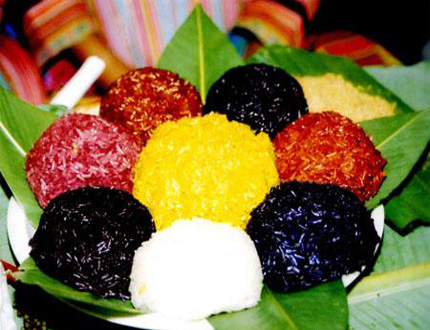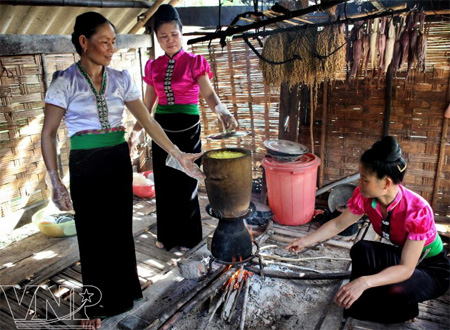Five-colour Steamed Glutinous Rice
For a long time, Xoi ngu sac (five-colour steamed glutinous rice) has been well-known as a specialty of Tay Bac (the north-western region of Vietnam). Its five colours forms a general one that symbolize Ying-Yang and five basic elements of the Eastern philosophy and the solidarity of the ethnic groups. However, each colour conveys a meaning of each ethnic group.
The Thai people in Muong Lo Valley have been in Tay Bac for a long time. They have distinctive cultural features, especially the cuisine culture. Among their traditional dishes, Xoi ngu sac shows both traditional and modern values and the fine philosophy of Yin and Yang and life.
We visited the family of Vi Quang Thuat in Hoc Hamlet, Son Thinh Commune, Van Chan District, Yen Bai Province to learn more about the specialty. The host was talking with us about the colours of the dish while making the dish. He said: “The hamlet’s elders told us that the dish has five different colours that create a general and close block.”


In the past, the locals only cooked Xoi ngu sac on special occasions, such as important festivals, ceremonies and weddings. Nevertheless, it now has becomes a very popular food in their daily life. Furthermore, the dish also shows the hospitality of the host and the level of his relations with the guests through the number of the dish’s colours.
To make delicious Xoi ngu sac, it is necessary to select Tu Le glutinous rice (Tan La glutinous rice in Thai language), a tasty rice which is grown in the Muong Lo Valley area. The water for making the dish must be taken from Muong Lo Stream because it helps make the food more delicious.
Leaves for making the dish’s colours must be carefully selected from the forest and they are not too young or too old. After being cleaned, the leaves are cooked in the water from the stream in Tu Le Commune. To create the red colour, the locals use leaves of Com xoi do (a variety of tree in the forest of Tay Bac) or mornordica fruits while using saffron’s juice to create yellow. To make purple steamed glutinous rice, locals use a special variety of glutinous rice which is soaked in water mixed with the ash of ginger leaves.
Each colour expresses a meaning, such as red for aspiration, purple for fertility, yellow for prosperity, green for mountains and forests in Tay Bac and white for a pure and faithful love. Furthermore, each colour of the dish is also seen on Thai women’s dresses.
The dish shows the creativeness of the Thai women in particular and women in Tay Bac in general, becoming the specialty of the area. Enjoying the dish, people will surely never forget its delicious taste and its colours.
Start planning your tailor-made Vietnam tour by contacting one of our specialists…







